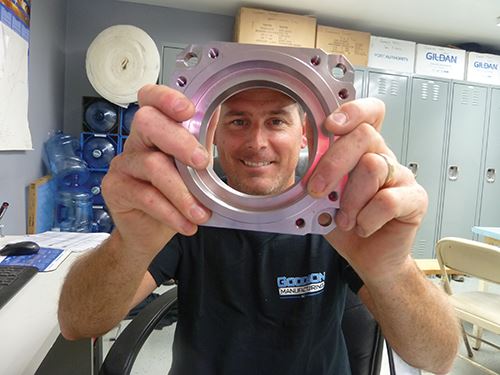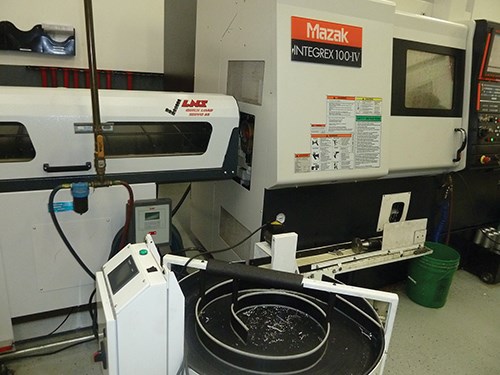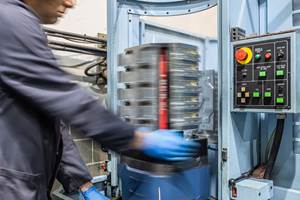Punching Above Your Weight
A multitasking machine enabled this small shop to bid competitively against larger operations by eliminating setups and reducing cycle times, but it first had to learn what jobs work best using turn-mill equipment.
Quoting a job is a complicated process. In order to outbid the competition, many factors must be taken into consideration, such as the cost of raw materials, equipment investment, spindle and cycle time, man hours, degree of automation, the ability to perform lights-out machining and the number of setups that will be required to make a particular part. Bid too high and lose the work; bid too low and lose your… profit margins. Finding the sweet spot is the secret to success.
Seeking to increase its competitiveness by adding new capabilities, Goodson Manufacturing—a seven-man shop located in Bohemia, New York—invested in a multitasking machine capable of both milling and turning that is enabling it to succeed in a crowded market, regularly quoting well below much larger operations.
Manufacturing parts for markets including automotive, printing, packaging, motion control and precision instrumentation, and working primarily with aluminum and stainless steel, the company was often forced to perform as many as six different setups on two machines—a horizontal mill and a lathe—on an average part before investing in a multitasking machine that could perform both functions in a single setup. The cycle time on an average part was also cut in half, from a total of 6 minutes on two machines to 3 minutes on one.
Still, skill and strategy is required to get the most out of a multitasking machine. Factors to be considered include machine allocation—what parts should be assigned to each, and why? To what degree can the process be automated in order to keep operation costs low, and what machine options are available that will complement your manufacturing configuration? An examination of the thought processes involved in both deciding to make such a hefty capital investment, as well as ensuring that both existing and new equipment capabilities are maximized, provides insights into the benefits of adopting multitasking.
One Man, One Machine
John and Jennifer Schilling founded Goodson Manufacturing in 2003. Based on Long Island, it is near the former location of his father’s machine shop, C.P. Schilling & Sons, which was launched by his grandfather in 1963. As the fifth of six brothers employed by the company, he worked there for 11 years before realizing he wanted to do something on his own. Although it was a difficult decision to leave the family business, he leased some space and started knocking on prospective clients’ doors. Five years later, in 2008, he purchased his father’s business once he was ready to retire.
In the early years, though, it was a bare-bones operation: “One man, one machine and one customer,” Mr. Schilling says with a laugh. That machine was a Mazak Matrix Nexus 510C-II four-axis vertical machining center, which he’d purchased new his first year in business. This allowed him to manufacture components for a specialty window company supplying the home construction market, which in turn provided the capital he needed to buy a second 510 VMC the next year. He spent 2 years “going to work at 3 in the morning, quoting until 7 a.m., running the machine until 7 that evening, and then answering emails about the quotes I’d sent that morning,” he says. “Then I’d go home and sleep for a few hours.”
By Goodson’s third year, revenues had increased to the point that Mr. Schilling was finally able to hire his first employee and add a Mazak QTN 100-II lathe. And although he’d increased the number of part numbers he was supplying his lone customer from 20 to about 200, the collapse of the housing market was beginning to loom on the horizon, so he realized he needed to diversify his customer base. One approach involved joining MFG.com, which he attended to assiduously for a year, landing some accounts that remain among his largest. As revenues increased, additional workers were hired, which allowed him to spend more time reaching out to potential customers. New equipment was purchased, as well. “I generally like to buy one new machine per year,” he says. “If you don’t keep up with the latest technologies, you’re sunk.”
The acquisition of C.P. Schilling & Sons in 2008 brought with it two employees as well as some older equipment—two of the first Integrex-style Mazak machines sold in the United States, in fact. One was an early turn-mill machine that was leading-edge when it was purchased, but couldn’t compete against newer multitasking machines in terms of power and holding tight tolerances. In 2011, he sold the two older machines to put a down payment on a new Integrex 100-IV turn-mill machine equipped with an LNS bar feeder
that is capable of loading 4-foot-long bars up to 2 inches in diameter and is linked to a 6-inch, three-jaw chuck. The machine has a 6,000 rpm turning spindle and a 12,000 rpm milling spindle. He could immediately see that he’d made a good investment, due to the elimination of multiple setups alone.
“Going from six setups to one saved an incredible amount of time, and it also improved quality because there was less handling of the parts,” Mr. Schilling says. “From that point on, anything we bid that required milling and turning became a candidate for the multitasking machine.”
For instance, Mr. Schilling says that a part that requires turning with some milling works best on a multitasking machine, but the degree of complexity dictates whether it can be produced in an unattended or lights-out manner. A part that has close tolerances of 0.0005 inch or less on several dimensions that requires machining from multiple angles is a good candidate. A part that requires more milling than turning generally works best on a separate mill and/or lathe. The reason is that, although the Integrex has a powerful milling spindle, you can only machine one piece at a time, while you can produce as many parts as can be fit on a pallet in a horizontal milling machine.
Multitasking Methodology
Although multitasking machines are produced by many OEMs, the basic definition of the process describes a single machine on which milling, turning, drilling, tapping, deep-hole boring, and even hobbing can be performed, allowing a part to be manufactured from raw material such as a blank or barstock all the way to the finished product. Multitasking can range from a basic setup to a more advanced configuration featuring a high degree of automation, depending on a shop’s requirements.
Goodson’s choice of the Integrex 100-IV turn-mill machine represents a fairly basic level, although he did connect automation at the beginning and end of the process. When Mr. Schilling purchased his multitasking machine, he chose an LNS Quick Load Servo 80 automatic magazine bar feeder, which features a “plug and play” interface with the Integrex, and a Rota-Rack parts accumulator from Royal Products. This enables the machine to run unmanned, and also in lights-out situations, which lowers the cost per part since an operator’s wages don’t have to be factored in. Along with the reduced cycle times on parts that can be manufactured completely from a blank on the multitasking machine, he is able to bid significantly lower than competitors who have not invested in multitasking equipment, at the same time receiving a fair profit for his work.
In determining which parts are well-suited for lights-out operation, Mr. Schilling points to several criteria. The first is cycle time, in that parts requiring longer periods of machining are ideal for overnight, unmanned machining. High-volume, repetitive work involving mass material removal also makes sense in a lights-out setting.
One part is ideal for this scenario. A cam lever, which is a simple solid cylinder with a male keyway-type feature at one end, can first be turned to the proper diameter before the feature is milled. Once the bar feeder is loaded and set up, the machine can run unattended, producing finished pieces that are then gathered in the parts accumulator. Again, the fact that minimal contact is required by this process increases quality and allows the company to bid competitively.
More complex parts can be produced as well, such as a right-angle housing, which is a small square structure with chambers, recesses and holes to be drilled. Turning pares down the barstock to the proper diameter before milling the irregular features called for in the plans.
Other parts for which multitasking machines are particularly well-suited include structural aircraft components, crankshafts, cylinder heads, spiral bevel gears, pump screws, medical implants, propellers and turbine blades. On the other hand, parts made of harder materials that cause increased tool wear run the risk of causing tool breakage and do not qualify for unmanned operation overnight. Parts that require shorter cycle times are generally run during the day, as are those causing high tool wear that may call for new inserts more frequently.
Fighting the Good Fight
Four years since buying his multitasking machine, Mr. Schilling points out the many ways it has helped a relatively small shop such as Goodson Manufacturing to compete with—and win against—larger companies that would seem more well-equipped at first glance.
First of all, he recalls tripling his workload in the 3 months following his purchase of the Integrex 100-IV since his bids came in so much lower compared to area competitors lacking multitasking capabilities. This was a mix of parts for new and existing customers in differing lot quantities, and also fast prototyping of both simple and complex parts. Unattended operation, bolstered by faster cycle times, brought his cost per part down to a range that allowed him to win the bid, and also for the profit margins to be high enough for the job to be worthwhile. Reduced setups on nearly every part run across the machine have also kept Goodson’s costs down.
Another benefit, Mr. Schilling says, is the user-friendly Mazatrol HMI, which he says is one of the most intuitive controls he’s encountered. “If you’re wanting to get into multitasking, this is the way to go,” he says, “because the control basically teaches you how to operate the machine. You find that new employees, even if they haven’t had any official training, get up to speed very quickly.”
The extra work the turn-mill combo brought in also allowed him to rethink his machine allocation, as well as what new machining processes would work for his shop. Once he had the Integrex in place he was able to buy the first of three horizontal machining centers with automatic pallet changers to allow for unmanned machining from Mazak. The most powerful is a Matrix 4000-III with a six-pallet manufacturing cell that basically runs every day, around the clock.
Mr. Schilling’s decision to go with this particular process and configuration is based on a number of things, one being the fact that these HMCs have a true fourth axis, which allows for several sides to be machined in one setup. Another involves the efficient use of manpower, since one operator can handle three machines with zero load time. The ability to conduct lights-out manufacturing thanks to the pallet system has basically doubled the company’s daily output in that department.
All of this, combined, allowed him the time he needed to diversify his customer base since he no longer felt compelled to accept “cookie-cutter” jobs. From a single customer during the first two years of operation to upwards of 100 today, he now has more protection against market fluctuations, and more capabilities that allow him to pursue new markets. Mr. Schilling knows that machine shops of all sizes must take advantage of any new technology or process that will give it an edge in a competitive situation. Apart from bidding against other companies for work, he says there is always the chance that a good customer will take their work overseas, which is something that he’s dealt with on plenty of occasions. But the new multitasking technology has allowed Goodson to adapt to a more competitive market.
“They will take their work overseas because of lower prices and then come back to me once they realize the parts they’re buying are inferior and cost more in the end. I’ve seen it happen time after time,” Mr. Schilling says. “But I’m going to keep fighting the good fight by investing in technologies like multitasking to make sure this shop is as efficient and competitive as possible.”
Related Content
When Too Many Customers Spoil the Part
Duo CNC used to take on as many customers as the shop could handle. But when growth stalled, a top-down audit by the company’s general manager revealed that its customer base was inhibiting growth — and causing the shop to be less efficient and productive.
Read MoreModern Bar Feeds Bring New Life to Automatic Swiss Lathes
Cam-actuated Swiss lathes are still the fastest way to process many parts. By adding modern bar feeders, this shop has dramatically improved their utilization with the ability to work unattended, even in a lights-out environment.
Read MoreWatchmaking: A Machinist’s View
Old-world craftsmanship combines with precision machining on a vertical machining center and Swiss-type lathe to produce some of the only U.S.-made mechanical wristwatch movements.
Read MoreHow to Reduce Cycle Times by 70% and More on Your Existing CNCs and Dramatically Improve Tool Life Too
By employing advanced high efficiency milling techniques for the entire machining routine, SolidCAM’s iMachining technology can drastically reduce cycle times while vastly improving tool life compared to traditional milling.
Read MoreRead Next
The Cut Scene: The Finer Details of Large-Format Machining
Small details and features can have an outsized impact on large parts, such as Barbco’s collapsible utility drill head.
Read More3 Mistakes That Cause CNC Programs to Fail
Despite enhancements to manufacturing technology, there are still issues today that can cause programs to fail. These failures can cause lost time, scrapped parts, damaged machines and even injured operators.
Read More

















.png;maxWidth=300;quality=90)



.png;maxWidth=300;quality=90)












